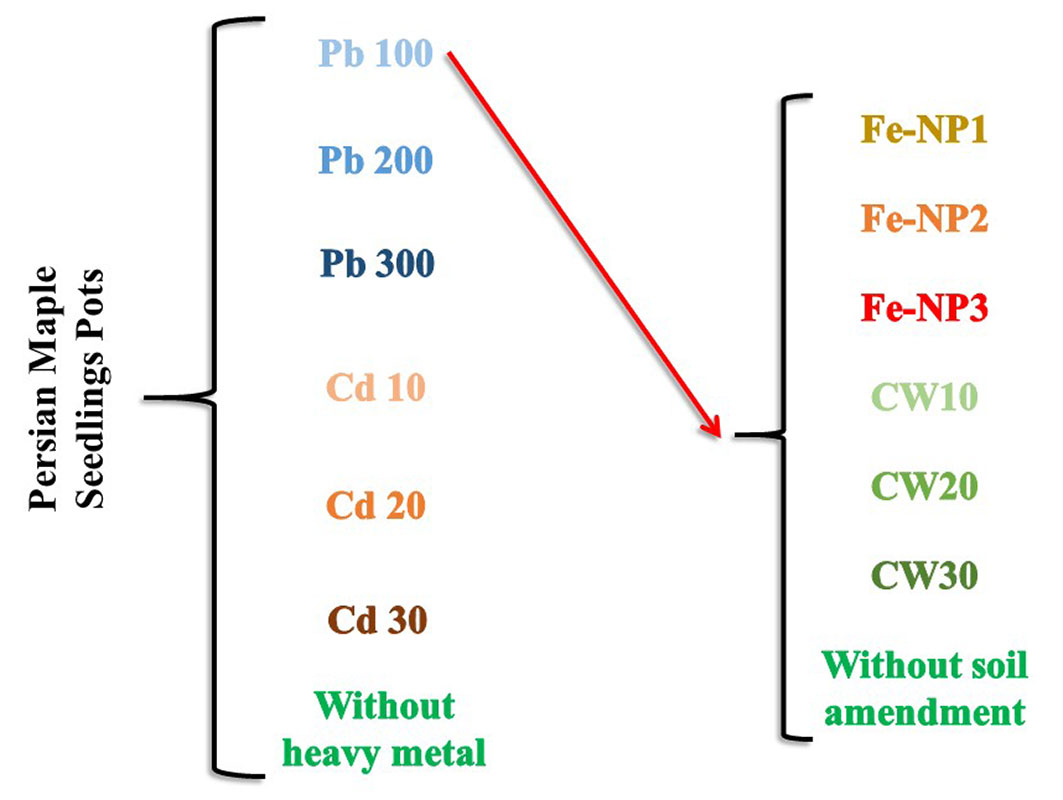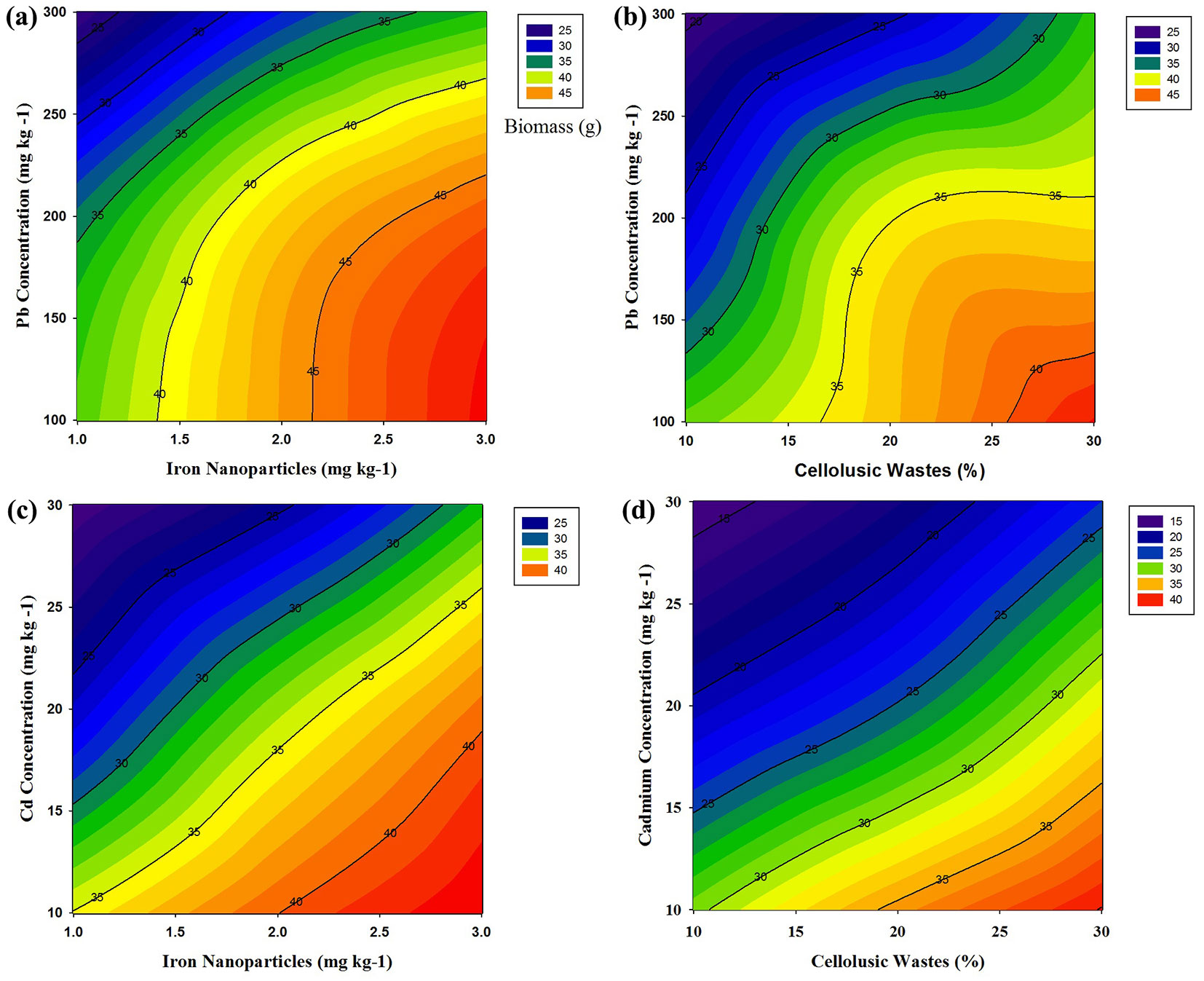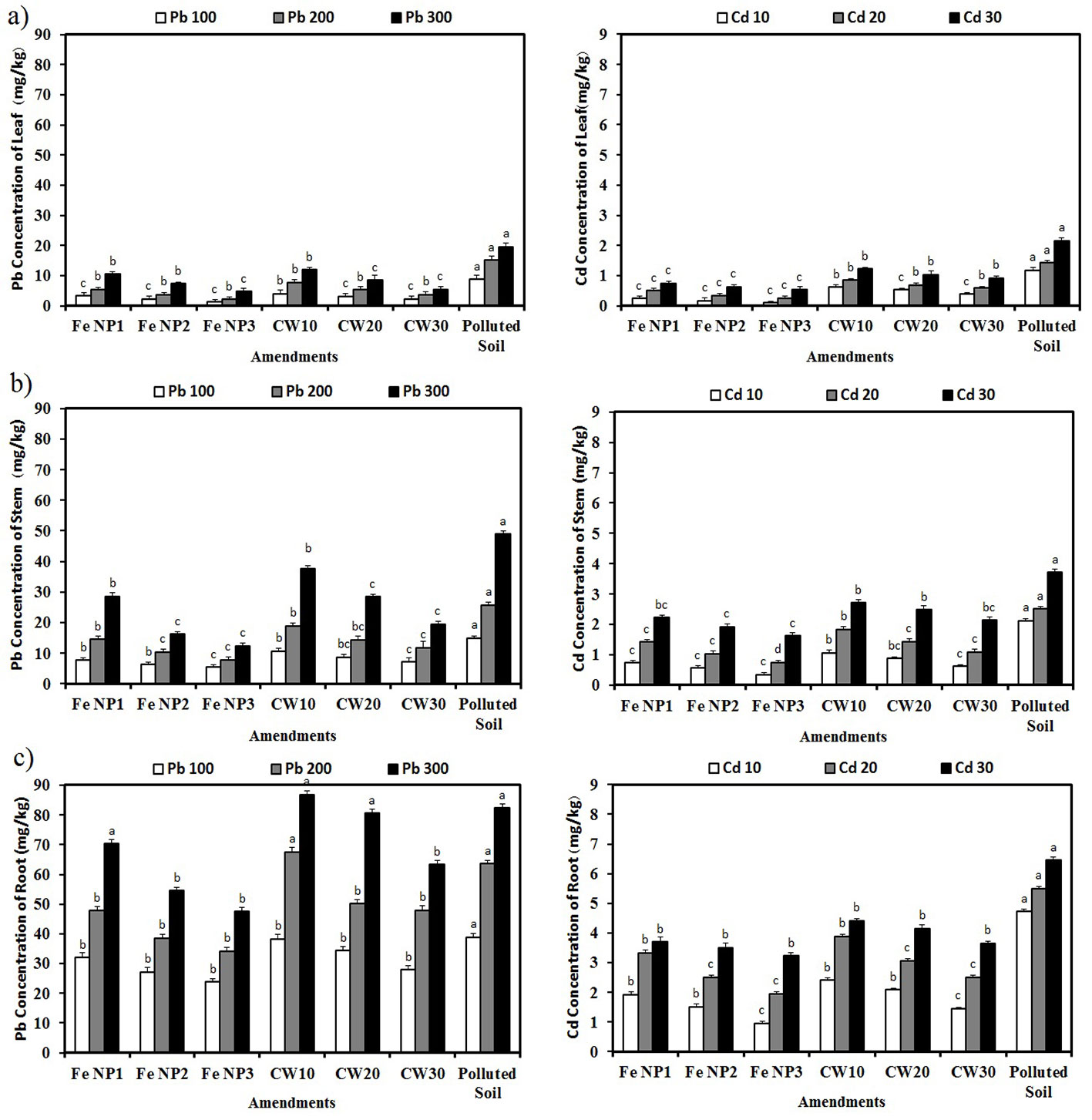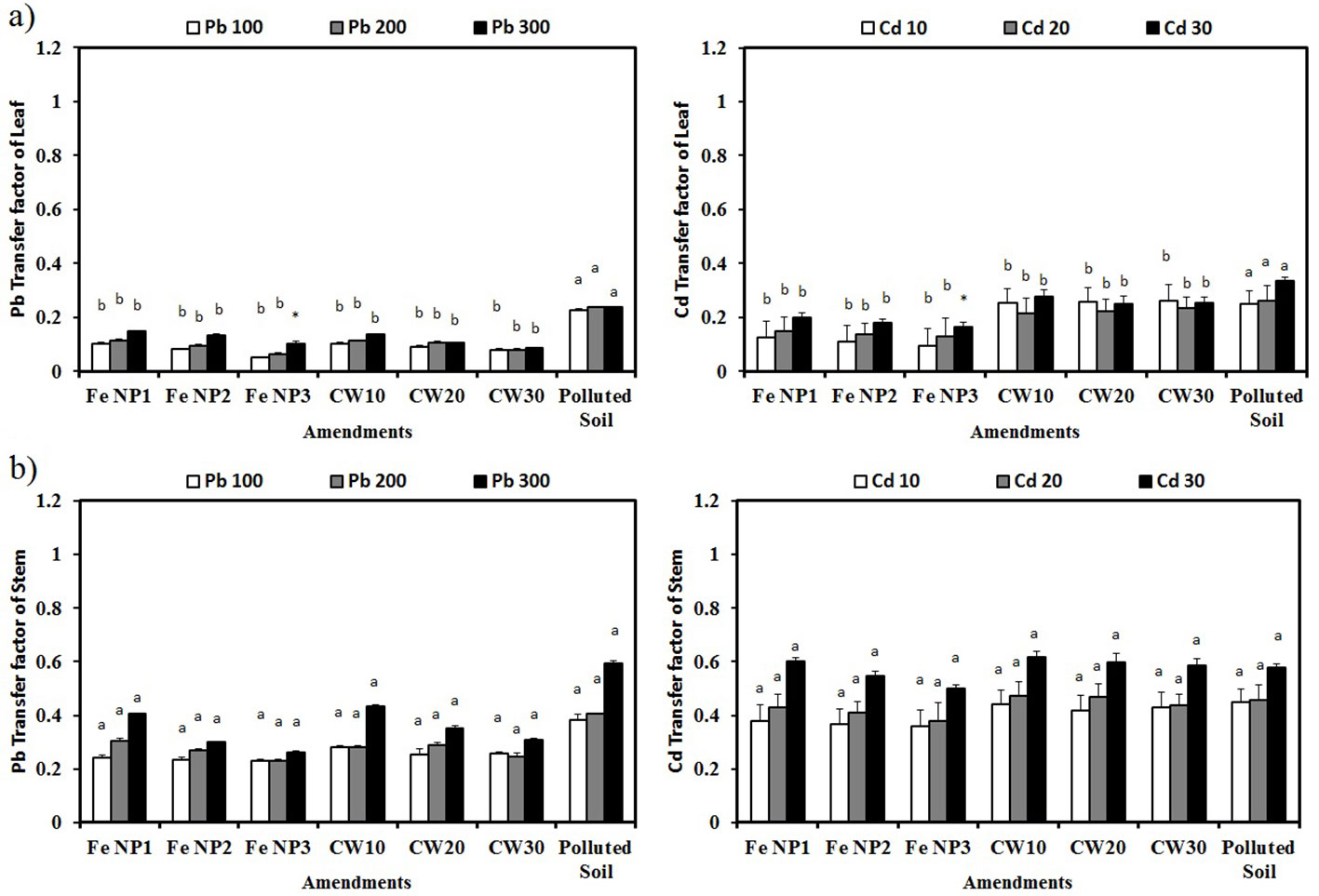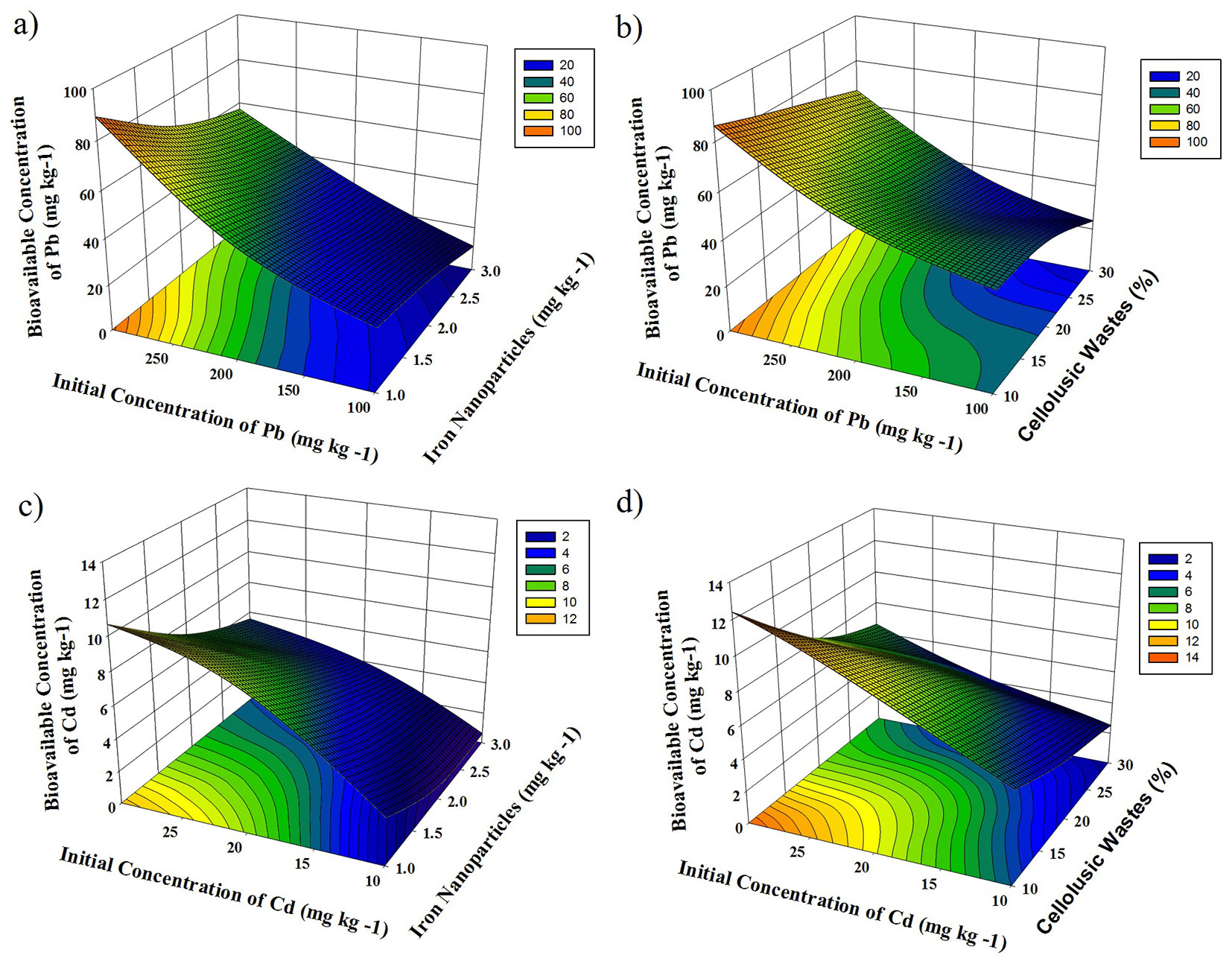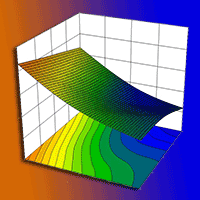
Using nano-scale Fe0 particles and organic waste to improve the nutritional status of tree seedlings growing in heavy metal-contaminated soil
iForest - Biogeosciences and Forestry, Volume 14, Issue 5, Pages 447-455 (2021)
doi: https://doi.org/10.3832/ifor3821-014
Published: Sep 28, 2021 - Copyright © 2021 SISEF
Research Articles
Abstract
The rehabilitation of heavy metal-contaminated lands is a challenging issue worldwide. The application of effective eco-friendly techniques and materials is necessary for amending the contaminated soils, and the in-situ results should be examined. The present study investigated the effect of zero-valent iron-nanoparticles (Fe0-NPs) and cellulosic wastes (CW) on the lead (Pb) and cadmium (Cd) uptake and nutrients’ (N, P, K) concentration of maple seedlings in contaminated soil. First, one-year-old seedlings were planted in pots containing unpolluted soil (volume = 3 Kg), and then the soil was contaminated by adding Pb (0, Pb100, Pb200, and Pb300 mg kg-1) and Cd (0, Cd10, Cd20, and Cd30 mg kg-1) solutions. The CW (0, 10, 20, 30 g/100g soil) and Fe0-NPs (0, 1, 2, 3 mg kg-1) treatments were applied to the soil before and after Pb and Cd addition, respectively. The biomass of seedlings and the concentration of nitrogen, potassium, and phosphorus in leaves were measured. Leaves, stems, and roots were digested to measure the Pb and Cd concentrations. Results showed that CW and Fe0-NPs improved N, P, and K concentrations in leaves at all levels of contamination. The lowest concentration of Pb and Cd in all organs and treatments was observed in the highest level of Fe0-NPs. The cellulosic waste and Fe0-NPs (the highest level only) significantly increased the soil pH at all levels of contamination. Our findings suggested that the use of Fe0-NPs (3 mg kg-1) and CW (30g/100g soil) could be appropriate for reducing the bioavailability of Pb and Cd in contaminated soil and improving the growth of maple seedlings.
Keywords
Soil Amendments, Zero-valent Iron, Heavy Metal Immobilization, Forest Rehabilitation
Introduction
Many anthropogenic activities such as fossil fuel consumption, mining, using sludge minerals, fertilizers, and pesticides can increase heavy metals pollution in different ecosystems ([21], [43]). The increased input of toxic heavy metals can potentially threaten ecosystems and human health, and has become an issue of great concern ([15]). Since forest ecosystems filter out the airborne pollutants, heavy metal loading from the atmosphere is especially high in the soils under forests ([1], [52]), resulting in a significant change of the heavy metal concentrations on both regional and international scales ([52]). Although pollutant emissions from factories have recently been considerably reduced, the increased heavy metals will persist for many decades and move rather slowly through the soil. In addition, many anthropogenic activities such as traditional coal mining have degraded and contaminated forest ecosystems.
Among heavy metals, lead (Pb) and cadmium (Cd) are considered as the most critical contaminants in an ecosystem because of their severe toxicity for living organisms even at low levels ([38]). High levels of Pb and Cd in the soil can exert many negative effects on soil functions such as the composition and activity of the microbial community, hindering plant growth, leading to leaves’ chlorosis and reducing enzymes activities ([36]); therefore, the establishment of plants in contaminated soils could fail, leading to land degradation.
The management and restoration practices of heavy metal-contaminated lands are a challenging issue worldwide because heavy metals in soil are non-biodegradable ([43]). In this regard, natural land restoration is advisable and possible, but it takes a longtime and, in the case of large disturbances and contamination, it is impossible to restore previous natural conditions. Therefore, human intervention and the use of appropriate novel techniques are necessary for accelerating the process of rehabilitation. In situ immobilization has been the most widely used technique for rehabilitation of heavy metal-contaminated lands. The main objective of these in situ remediation strategies is to reduce the bioavailability (mobile fraction) of heavy metals (by metal sorption, precipitation, and complexation) in soils that could reach the groundwater or that can be taken up by organisms and plants ([15]).
Different types of soil amendments, including clay minerals, biochar, phosphates, and iron oxides have been used for heavy metal immobilization ([60]). However, to rehabilitate large areas of contaminated/degraded lands, the use of a cost- effective and environmentally friendly amendment is essential ([57]). One of these potential amendments for heavy metal immobilization proposed in previous studies is the use of cellulosic wastes (CW); apart from their positive effect on heavy metal immobilization, they also provide a satisfactory alternative to the reuse of waste materials ([35], [3], [51]). However, the effects of the in-situ application of these amendments on soil and plant properties are still unclear.
Along with the development of nanotechnology, nanoparticles have emerged as new possible nano-amendments for the rehabilitation of contaminated soils ([11]). Among these nano-amendments, zero-valent iron nanoparticles (Fe0-NPs) are the most widely used in soil and water. The Fe0-NPs, low-cost materials with a strong adsorption ability, are strong reductants and can reduce the bioavailability of heavy metals in soil environments ([61]). Still, major challenges remain unresolved for the in situ applications and the effect of Fe0-NPs on plants.
In general, the soil amendments for the rehabilitation of contaminated forests are frequently combined with the afforestation practices. The establishment of a suitable pioneer plant such as maple seedlings in the contaminated forest is helpful in preventing the dispersion of contaminants through erosion, run-off, and percolation, while increasing biodiversity. The mixture of soil with CW and/or Fe0-NPs in planting holes is an effective method for establishing the native pioneer tree species’ seedlings and accelerating the rehabilitation of contaminated forests ([34]). After years, the litterfall of the planted trees can increase the soil organic matter and eventually lead to land rehabilitation ([56]).
Previous studies on the effect of soil amendments have focused on the seedling biomass and bioavailable concentration of Pb and Cd in the soil ([50]). However, examinations of the effect of soil amendments in polluted soil on the concentration of heavy metals and macro-elements in forest seedlings’ organs are still scarce. Therefore, the present study determined the effect of CW and Fe0-NPs on the nutrients’ (N, P, and K) and heavy metals’ concentration of Acer velutinum seedlings, as well as the soil properties in Pb and Cd-contaminated soil. It was hypothesized that soil amendment should have potentials for: (i) reducing Pb and Cd uptake by seedlings; (ii) improving soil reaction; and (iii) increasing seedling biomass and nutrient concentrations in the leaves. The results of this study can be useful for the management and reclamation of the heavy metal-contaminated soil and rehabilitation of degraded lands in forested areas.
Materials and methods
Pot experiments
Pots containing unpolluted soil (Tab. 1) were used for planting one-year-old seedlings of Acer velutinum (height of 46.21 ± 2.1 cm and diameter of 0.50 ± 0.02 cm), on March 1st, 2014. The pots were kept in a forest nursery (location: 36° 33′ 58.5″ N, 53° 21′ 56.6″ E; elevation: 120 m a.s.l.; rainfall: 790 mm; mean annual temperature: 19 °C).
Tab. 1 - Physical and chemical properties (mean values ± SE) of unpolluted soil used in pot experiment.
| Property | Value |
|---|---|
| Texture (% Sand : Silt : Clay) | 49.2 : 29.2 : 21.6 |
| pH | 7.15 ± 0.01 |
| EC (µS cm-1) | 730 ± 2.1 |
| OM (%) | 10.99 ± 0.3 |
| N (%) | 0.34 ± 0.02 |
| P (mg kg-1) | 8.31 ± 0.2 |
| K (mg kg-1) | 407.4 ± 4.4 |
The soil was contaminated with Pb and Cd aqueous solutions. First, nitrate salts including Pb(NO3)2 and Cd(NO3)2 were dissolved in de-ionized water to prepare the Pb and Cd aqueous solutions, respectively. Then, the Pb solution with concentrations of 0, 100, 200, and 300 mg kg-1 (treatments: control, Pb100, Pb200, and Pb300, respectively) and the Cd solution with concentrations of 0, 10, 20, and 30 mg kg-1 (treatments: control, Cd10, Cd20, and Cd30, respectively) were added to the pots ([22]), taking care that a pot would not receive the two solutions simultaneously.
Soil amendments
Zero-valent iron nanoparticles (Fe0-NPs) were prepared using the reduction method (Fe3+ to Fe0) in cold distilled water in the laboratory condition (without air evacuation). Ascorbic acid was used to stabilize Fe0-NPs and prevent aggregation ([32], [45]). In this way, the NaBH4 reduction method was adopted to synthesize Fe0-NPs without using an inert gas ([45] - eqn. 1):
Four weeks after polluting the soil, the Fe0-NPs solution was injected into the pots at four levels of 0 (no amendment), 1 (Fe-NP1), 2 (Fe-NP2), and 3 (Fe-NP3) mg kg-1, taking care that a pot would only receive one level of the solution.
The CW was purchased from the Mazandaran Wood and Paper Factory (Iran). These waste materials were made of native tree species of Hyrcanian forests. According to previous studies, addition of maximum 30% (30 g/100 g soil) of organic amendment should be added to the heavy metal contaminated soil ([8], [7], [49]); for this reason four levels of CW were considered: 0 (no amendment), 10 (CW10), 20 (CW20), and 30 (CW30) g/100 g soil, and were then mixed with the soil at the same time of planting.
Laboratory analysis
The leaves, stems, and roots of each maple seedling were weighed after drying (70 °C for 48 h) at the end of the study period (November 2014). The mentioned organs were then digested (a mixture of H2SO4 and H2O2) to determine the concentration of heavy metals ([19]). Concentrations of Pb and Cd in the digest were measured by an atomic absorption spectrophotometer (Contra AA®, Analytik, Jena, Germany). Nitrogen (N), phosphorus (P), and potassium (K) concentrations of the leaves were also measured. In order to determine the nitrogen concentration in leaves, the Kjeldahl method was used as described by Jackson ([19]). The vanado-molybdate phosphoric yellow color method in the nitric acid system was used according to Jackson ([19]) to determine the phosphorus concentration in leaves. The potassium concentration in leaves was measured by a flame photometer (PFP7®, Jenway, Stone, UK).
At the end of the experiment, soil samples were taken from each pot to measure the pH, organic carbon percentage (OC), and Pb and Cd bioavailable concentrations. In the laboratory, a pH meter (1:2.5, soil: water suspension) and the Walkley and Black method were used to measure the soil pH and OC, respectively. The bioavailable concentrations of Pb and Cd were assessed by the method of Quevauviller et al. ([42]). The resulting suspension was filtered by a filter paper and, finally, Pb and Cd were measured by an atomic absorption spectrometer (Contra AA®, Analytik, Jena, Germany). The accuracy evaluation was performed using the certified reference material.
Calculation and statistical analysis
In this study, a completely randomized design was set up. The reclamation treatments included CW10, CW20, CW30, Fe-NP1, Fe-NP2, and Fe-NP3. Pots without heavy metals and amendments were the controls, while pots with heavy metals and without amendments were regarded as the polluted soil. Each case (CW10-Cd10, CW10-Cd20, etc.) had eight replicates of seedlings (Fig. 1).
The translocation factor of heavy metals was calculated with the following equation (eqn. 2):
where Ca and Cr are the aboveground and roots’ heavy metal concentrations, respectively ([33], [10]).
All the results are presented as the mean values with standard error (± SE). The normality of the variables and the homogeneity of variances were checked by the Kolmogorov-Smirnov test and Levene’s test, respectively. Data were analyzed using the software SPSS® Statistics v. 26 (IBM, Armonk, NY, USA). A two-way analysis of variance (ANOVA) was applied to the data in order to evaluate the effect of heavy metal levels, amendments levels, and the interaction between heavy metal and amendments. The SNK test was performed to compare the means (p≤0.05).
Results
Effects of amendments on soil pH and organic carbon
The results of two-way ANOVA showed that the heavy metals (lead and cadmium) had a significant effect on the soil pH, while they had no effect on the soil EC. In addition, the main effect of soil amendments on the soil pH and EC were significant. However, the interaction of heavy metals and soil amendments had no effect on the soil pH and EC (Tab. S1 in Supplementary material). The use of CW (all levels) and Fe-NP3 significantly increased the soil pH at all levels of contamination compared with the control. An increasing trend in the soil pH was observed with increasing the levels of CW (Fig. 2). CW significantly increased the soil C content in comparison with control, while Fe0-NPs demonstrated no significant effect. An increasing trend of soil C content was also observed with increasing the levels of cellulosic waste. The highest pH and OC in the Pb and Cd-contaminated soil were recorded in CW30.
Fig. 2 - Effect of different levels of iron nanoparticles (Fe-NP) and Cellulosic Wastes (CW) on Pb and Cd contaminated soil pH (a) and OC (b). Different letters represent significant differences between treatments within each concentration. Asterisks (*) indicate the significant difference between treatments and control (vertical bars indicate SE).
Effect of soil amendments on seedling biomass
The results showed that the biomass of Acer velutinum seedlings was affected by the initial concentration of Pb (Fig. 3a, Fig. 3b) and Cd (Fig. 3c, Fig. 3d), which decreased the seedlings’ biomass. However, with an increase in the Fe0-NP and CW levels, the biomass of seedlings also increased. The highest biomass of seedlings was observed at a high level of Fe0-NP in response to all the levels of Pb and Cd.
Fig. 3 - Biomass of Acer velutinum seedlings: (a) as a function of Pb concentration and nanoparticles level; (b) as a function of Pb concentration and cellulosic wastes level; (c) as a function of Cd concentration and nanoparticles level; and (d) as a function of Cd concentration and cellulosic wastes level.
Nutrient concentrations
The results of two-way ANOVA showed that the heavy metals and soil amendments had a significant effect on the leaf nutrient; while, the interaction of heavy metals and soil amendments had no significant effect on the leaf nutrients (Tab. S2 in Supplementary material). According to our results, Pb and Cd affected the nitrogen, phosphorus, and potassium of leaves (Fig. 4); accordingly, they were significantly lower in the polluted soil (p<0.05). A decreasing trend in the leaves’ nutrient concentration was observed with increasing Pb and Cd concentrations in all treatments. The CW and Fe0-NP significantly improved the N, P, and K concentrations in the leaves in comparison with the polluted soil. There was no significant difference (p>0.05) in these nutrients’ concentrations between CW and Fe0-NP levels of all concentrations of Pb and Cd (Fig. 4).
Fig. 4 - Effect of different levels of nanoparticles (Fe-NP) and cellulosic wastes (CW) on leaf Nitrogen (a), Phosphorus (b) and Potassium (c) in different concentrations of Pb and Cd contaminated soil. Different letters represent significant differences between treatments within each concentration. Asterisks (*) indicate the significant difference between treatments and control. Vertical bars indicate SE.
Heavy metal concentrations in plant organs
The results of two-way ANOVA showed that the heavy metals, soil amendments and their interaction had a significant effect on the heavy metal concentrations in plant organs (Tab. S3 in Supplementary material). The Pb and Cd concentrations of leaves, stems, and roots in polluted soil were significantly higher (p<0.05) in comparison with the amended ones (CW and Fe0-NP - Fig. 5). A significant difference between CW and Fe0-NP treatments was obtained in leaves, except for the lowest concentration of Pb (Pb 100) and Cd (Cd 10 - Fig. 5); however, significant differences of the heavy metal concentration in stems and roots were observed between CW and Fe0-NP treatments for all levels of pollution. There was an increasing trend in the heavy metal concentration in leaves, stems, and roots with increasing the Pb and Cd concentration in the soil. The lowest concentration of Pb and Cd in leaves, stems, and roots were observed in Fe-NP3 for all pollution levels (Fig. 5).
Fig. 5 - Effect of different levels of nanoparticles (Fe-NP) and cellulosic wastes (CW) on Pb and Cd concentration in leaf (a), Stem (b) and root (c). Different letters represent significant differences between treatments within each concentration. Asterisks (*) indicate the significant difference between treatments and control. Vertical bars indicate SE.
Translocation factor (TF)
The results of two-way ANOVA showed that the heavy metals, soil amendments and their interaction had a significant effect on the heavy metal Translocation Factor (TF) in plant organs (Tab. S4 in Supplementary material). Based on the results, the TF of Pb and Cd for the leaves was significantly higher in the polluted soil compared with the amended ones, and there was no significant difference between CW and Fe0-NP treatments (p>0.05). In addition, there was no significant difference (p>0.05) in Pb and Cd transfer factor for the stems between the polluted and amended soils. There was an increasing trend in the TF of Pb and Cd with pollution levels. The highest TF of Pb and Cd for the leaves and stems was found in the polluted soil (Fig. 6).
Fig. 6 - Effect of different levels of nanoparticles (Fe-NP) and cellulosic wastes (CW) on Pb and Cd Transfer Factor of leaf (a) and Stem (b). Different letters represent significant differences between treatments within each concentration. Asterisks (*) indicate the significant difference between treatments and control (vertical bars indicate SE).
Effect of soil amendments on heavy metal concentrations in soil
Bioavailable concentrations of Pb and Cd in the soil as a function of initial concentration heavy metals and soil amendments levels are presented in Fig. 7. The application of CW and Fe0-NPs significantly decreased Pb and Cd bioavailability in the soil. The concentration of Pb and Cd decreased with an increase in the CW and Fe0-NP levels. In general, Fe0-NP caused a lower bioavailability of Pb and Cd than CW. The lowest bioavailability for all concentrations of Pb (Pb100: 11.1 mg.Kg-1, Pb200: 30.7 mg Kg-1, Pb300: 86.1 mg.Kg-1) and Cd (Cd10: 0.6 mg Kg-1, Cd20: 3.9 mg Kg-1, Cd30: 5.5 mg Kg-1) was observed in the Fe-NP3 treatment (Fig. 7).
Fig. 7 - Bioavailable concentration of heavy metals in soil: (a) as a function of Pb concentration and nanoparticles level; (b) as a function of Pb concentration and cellulosic wastes level; (c) as a function of Cd concentration and nanoparticles level; and (d) as a function of Cd concentration and cellulosic wastes level.
Discussion
In this study the biomass variation of maple seedlings was investigated as a function of heavy metal concentration and soil amendment levels. Our results showed that the Pb and Cd addition to the soil had a significant effect on the maple seedlings’ biomass; also, increasing the concentrations of Pb and Cd decreased the biomass in all treatments, whereas increasing in the amendment level (CW and Fe0-NPs) increased the biomass in all pollution levels. Negative effects on the physiological processes can be seen when Pb enters the cells. Some Pb phytotoxicity effects include changes in the hormonal status and enzyme activities, as well as the effect on the mineral nutrition uptake, which can disturb normal physiological activities ([47]). Cell division may be inhibited by the presence of Cd in plants, and the synthesis of RNA can be changed ([30]). Various studies reported that the seedling growth of different species, as well as maple seedling, was affected by Pb and Cd ([50], [36]). Other reasons for the decreasing trend in the seedling biomass resulting from high concentrations of heavy metals in the soil might be due to the disturbance or prevention of the nutrient uptake by plants and photosynthetic activities ([5]).
The results revealed that the biomass of maple seedlings increased with amendment levels. The organic amendments are effective in improving the physical and chemical properties of soils, with positive effects on the plant biomass ([23]). An increase in the biomass of seedlings upon adding organic matter such as CW might be due to the higher amount of macronutrients ([14]), increased soil organic matter, and better biological activities ([41]). The positive effect of CW on plant biomass was reported in previous studies ([25], [3]). Cellulose production waste contains many valuable components, including organic compounds as well as macro- and microelements essential to plants ([14]). The composition of cellulose production waste includes calcium and magnesium, which can occur in carbonate, oxide, and silicate form. Cellulose production waste contains small quantities of calcium and alkaline metal hydroxides as well as aluminosilicates. Positive effect of other organic soil amendments on plant growth was reported in previous studies ([40], [9], [2]).
An increase in seedling biomass with the addition of Fe0-NPs could be due to the positive effects of iron on seedlings’ photosynthesis, which was also reported in previous study on maple seedlings ([50]). Several studies reported the stimulation of plant seedling development and growth by Fe0-NPs ([39]). This benefit may occur because Fe0-NPs provide bioavailable iron as a nutrient, or increase the phytohormone content and antioxidant enzyme activity; however, further studies are needed for providing more details ([61]). The main reason for the improvement of seedling biomass with the addition of CW and Fe0-NPs could be the conversion of Pb and Cd to a less bioavailable state in the soil (as measured in this study), thus blocking heavy metal uptake by the seedling and reducing the negative effect of heavy metal on seedling functions ([58]).
The Pb and Cd treatments had significant effects on the nutrient concentration of leaves. Other studies also revealed that plant nutrient uptake can be significantly influenced by Pb ([17]). The general reduction in the concentration of N in plants could be induced by the lowered activity of nitrate reductase ([46]).
The results indicated that using CW and Fe0-NPs did improve nutrient concentrations in the leaves in comparison with control. The addition of organic matter as amendments can provide a slow release of nutrient sources such as N, P, and K to support plant growth ([56]) and improve the soil physical properties and nutrient status ([59]). The competition between the absorption of heavy metals and nutrients by plants can be reduced by the reduction of bioavailability of heavy metals after CW addition. Mehmood et al. ([38]) suggested that the addition of organic matter to soil improved plant nutrient uptake by limiting the heavy metal bioavailable concentration in the soil. Positive effects of Fe0-NPs on nutrient uptake by plants were also reported in previous studies ([24], [6]). It is still not clear how Fe-NPs alone can increase the macronutrient uptake (e.g., N, P, and K) by plants. However, Kim et al. ([24]) reported that Fe0-NPs could enhance the root elongation and subsequently increase the endocytosis in the roots’ cells. Finally, this could be a pathway for increasing nutrient uptake by plants. Fe0-NPs could reduce the bioavailability of heavy metals and, subsequently, decrease the competition of nutrients with heavy metals for plant uptake ([31], [58]).
The trend of changes in Pb and Cd concentrations in different organs of maple seedlings was as follows: roots > stems > leaves. Previous studies on eucalyptus, poplar, and maple demonstrated that the highest concentration of Pb and Cd was observed in the roots ([29]). The mechanisms of heavy metal uptake and distribution are very complex. Heavy metals differ substantially according to their accumulation in the plant roots and shoots ([26]). Cd tends to accumulate in the roots and shoots, while Pb accumulates in the roots ([48]).
The TF of Cd was greater than Pb because of the mobility of Cd in the plant systems. Cd is easily absorbed by plants and transferred to different organs ([22]). A large amount of Pb is accumulated in the roots, and only a small amount is transferred to the aboveground parts of the plants. Several authors suggested that the endodermis functions act as a barrier to the radial transport of Pb in the roots ([20]). Gray et al. ([18]) reported the reduction of Cd uptake by plants when using soil organic amendments.
In this study the bioavailabile concentrations of Pb and Cd were provided as a function of initial concentration of heavy metals and soil amendments level. The addition of CW and Fe0-NPs caused a significant decrease in the bioavailability of Pb and Cd in the soil, which is consistent with the findings of Tafazoli et al. ([50]), Danila et al. ([13]), and Xu et al. ([58]). The addition of organic matters can affect the availability of heavy metals in the soil through the formation of chelate and complexes of organic materials. Therefore, the application of organic matters and related amendments such as CW immobilizes heavy metals in contaminated soils ([44], [50]). Negative-charged functional groups (e.g., carboxylic acids, phenolic and alcoholic hydroxyls) could form complexes with Pb and Cd to decrease their availability ([55], [54]). Cellulosic wastes contain oxygen functional groups including carbonyl groups, hydroxyl groups and ether. These functional groups can bind heavy metal ions and organic small molecule contaminants by cheating, completing, coordinating, hydrogen bonding and the like, which play an important part in the preparation of adsorbents ([12]). Heavy metal immobilization mechanisms with the addition of Fe0-NPs depend on the standard redox potential (E0) of the metal contaminant. Metals with an E0 similar to or more negative than Fe0-NPs (e.g. Cd) are merely removed by adsorption to the iron (hydr)oxide shell. Metals that have an E0 slightly more positive than Fe-NPs can be removed by both reduction and adsorption ([31]).
The application of CW significantly increased the soil pH and OC; the addition of Fe0-NPs increased the soil pH compared to the control treatment. Increased OC by adding CW can be due to the high content of C and labile C in the fresh organic matter, as well as improved microbial activities and organic matter decomposition ([4]). Increased OC by adding the organic matter was reported by Zhang et al. ([62]) and Venegas et al. ([53]). Increased soil pH by adding CW may result from organic matter decomposition, the slow release of nutrients and NH4+ from CW, and the adsorption of H+ ions on exchangeable sites on the organic colloids ([55]). Many partially decomposed plant tissues contain ring structures and C chains with chemically active groups of atoms that expose the soil to hydroxyl groups. The carboxyl groups on the humus develop a negative charge that can adsorb H+ ions ([55]). Gil-Díaz et al. ([16]), Kumpiene et al. ([28]), and Xu et al. ([58]) also stated that Fe0-NPs and iron powders increase the soil pH, which may depend upon the oxidation of Fe0-NPs ([27]). Generally, Fe0-NPs can react with dissolved oxygen in aerobic conditions. Water is produced in the presence of zero-valent iron, H+, and O2, and the consumption of H+ can increase the soil pH resulting from the production of iron hydroxide, which can decrease the bioavailability of heavy metals ([37]). In addition, zero-valent iron acts with water in anaerobic conditions and produces H2 and OH-, and pH would increase as a result of increased OH- ([37]).
Conclusion
The effects of two cost-effective and eco-friendly soil amendments, i.e., cellulosic wastes (CW) and zero-valent iron nanoparticles (Fe0-NPs), on the uptake of nutrients (N, P, and K) and heavy metals (Pb and Cd) by Acer velutinum seedlings were investigated. Both amendments improved the seedling biomass and nutrient concentration and reduced heavy metal uptake by seedlings at high levels (30 g/100 g soil CW and 3 mg kg-1 Fe0-NPs). In addition, CW and Fe0-NPs improved the soil pH and OC in the contaminated soil. Based on our results, and previous studies, the use of CW and Fe0-NPs could be an appropriate way for the soil reclamation and seedling establishment in heavy metal-contaminated lands for accelerating the rehabilitation practices. As ascorbic acid can be used to produce Fe0-NPs (as a coating agent to prevent Fe0-NPs from aggregation), the waste of organic matters produced in orange juice factories, for example, can be used to extract ascorbic acid, and this can also be in line with waste management. Considering the high costs and the difficulty of the transportation of large amounts of CW to contaminated forests/lands for use in planting holes, it seems that Fe0-NP is a better option. The use of CW will also lead to soil disturbance; however, Fe0-NP can be injected into the soil, and is thus superior in this respect. Further studies are warranted due to the lack of information about the effects of soil amendments on the different fraction of heavy metals in soil, plant physiology, uptake of other macro- and micro-nutrients by plants, and soil biological properties.
Acknowledgements
The authors thank the Iranian Nanotechnology Initiative Council and Sari Agricultural Sciences and Natural Resources University (Iran) for financial support. We also thank Georg-August Göttingen University (Germany) and the staff of Soil Science of the Temperate Zone Institute for their kind cooperation.
References
Gscholar
Gscholar
CrossRef | Gscholar
CrossRef | Gscholar
Gscholar
Gscholar
Gscholar
CrossRef | Gscholar
Authors’ Info
Authors’ Affiliation
Seyed Mohammad Hojjati 0000-0003-3976-5599
Department of Forestry, Sari Agricultural Sciences and Natural Resources University, Sari 4818168984 (Iran)
Department of Basic Sciences, Sari Agricultural Sciences and Natural Resources University, Sari 4818168984 (Iran)
Department of Range Management, Faculty of Natural Resources & Marine Sciences, Tarbiat Modares University, Noor (Iran)
Department of Temperate Soil Science, University of Göttingen, Institute of Soil Science, Göttingen 37077 (Germany)
Corresponding author
Paper Info
Citation
Tafazoli M, Hojjati SM, Biparva P, Kooch Y, Lamersdorf N (2021). Using nano-scale Fe0 particles and organic waste to improve the nutritional status of tree seedlings growing in heavy metal-contaminated soil. iForest 14: 447-455. - doi: 10.3832/ifor3821-014
Academic Editor
Daniela Baldantoni
Paper history
Received: Mar 22, 2021
Accepted: Aug 05, 2021
First online: Sep 28, 2021
Publication Date: Oct 31, 2021
Publication Time: 1.80 months
Copyright Information
© SISEF - The Italian Society of Silviculture and Forest Ecology 2021
Open Access
This article is distributed under the terms of the Creative Commons Attribution-Non Commercial 4.0 International (https://creativecommons.org/licenses/by-nc/4.0/), which permits unrestricted use, distribution, and reproduction in any medium, provided you give appropriate credit to the original author(s) and the source, provide a link to the Creative Commons license, and indicate if changes were made.
Web Metrics
Breakdown by View Type
Article Usage
Total Article Views: 31827
(from publication date up to now)
Breakdown by View Type
HTML Page Views: 26552
Abstract Page Views: 2899
PDF Downloads: 1859
Citation/Reference Downloads: 5
XML Downloads: 512
Web Metrics
Days since publication: 1577
Overall contacts: 31827
Avg. contacts per week: 141.27
Article Citations
Article citations are based on data periodically collected from the Clarivate Web of Science web site
(last update: Mar 2025)
Total number of cites (since 2021): 3
Average cites per year: 0.60
Publication Metrics
by Dimensions ©
Articles citing this article
List of the papers citing this article based on CrossRef Cited-by.
Related Contents
iForest Similar Articles
Research Articles
Bioaccumulation of long-term atmospheric heavy metal pollution within the Carpathian arch: monumental trees and their leaves memoir
vol. 17, pp. 370-377 (online: 27 November 2024)
Research Articles
Heavy metal (Zn, Pb, Cd) concentration in soil and moss (Pleurozium schreberii) in the Brynica district, southern Poland
vol. 4, pp. 176-180 (online: 11 August 2011)
Research Articles
Heavy metal accumulation characteristics of Nepalese alder (Alnus nepalensis) growing in a lead-zinc spoil heap, Yunnan, south-western China
vol. 7, pp. 204-208 (online: 27 February 2014)
Research Articles
Tolerance to heavy metal stress in seedlings of three pine species from contrasting environmental conditions in Chile
vol. 9, pp. 937-945 (online: 12 August 2016)
Review Papers
Heavy metals and woody plants - biotechnologies for phytoremediation
vol. 4, pp. 7-15 (online: 27 January 2011)
Review Papers
Monitoring the effects of air pollution on forest condition in Europe: is crown defoliation an adequate indicator?
vol. 3, pp. 86-88 (online: 15 July 2010)
Research Articles
Analysis of biometric, physiological, and biochemical traits to evaluate the cadmium phytoremediation ability of eucalypt plants under hydroponics
vol. 10, pp. 416-421 (online: 24 March 2017)
Research Articles
Variation of major elements and heavy metals occurrence in hybrid aspen (Populus tremuloides Michx. × P. tremula L.) tree rings in marginal land
vol. 13, pp. 24-32 (online: 15 January 2020)
Technical Reports
Air pollution regulations in Turkey and harmonization with the EU legislation
vol. 4, pp. 181-185 (online: 11 August 2011)
Research Articles
Temporal analysis of pollutant metals in trees of three parks in Mexico City’s Metropolitan Area
vol. 18, pp. 138-145 (online: 01 June 2025)
iForest Database Search
Search By Author
Search By Keyword
Google Scholar Search
Citing Articles
Search By Author
Search By Keywords
PubMed Search
Search By Author
Search By Keyword

